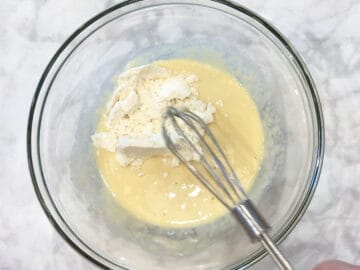
Fluffy Protein Pancakes
These fluffy protein pancakes take 20 minutes to make, contain just six ingredients, and each serving has 32 grams of protein!
Servings 2 servings
Calories 228kcal
Ingredients
- 2 large eggs
- 1 tablespoon vanilla extract
- 1 teaspoon stevia glycerite equals ⅓ cup of sugar; omit if using sweetened protein powder
- ½ cup plain Greek yogurt not regular yogurt
- 2 scoops unsweetened whey protein powder level, not packed; 40 grams total; see notes below
- 1 teaspoon baking powder gluten-free if needed
- Avocado oil cooking spray for the griddle
Instructions
- In a medium bowl, whisk the eggs, vanilla, stevia, and yogurt.2 large eggs, 1 tablespoon vanilla extract, 1 teaspoon stevia glycerite, ½ cup plain Greek yogurt

- Add the protein powder and whisk until completely smooth and blended. Use a rubber spatula to scrape the sides of the bowl if needed.2 scoops unsweetened whey protein powder

- Whisk in the baking powder. Let the batter rest while you heat the griddle. It slightly thickens as it rests.1 teaspoon baking powder

- Heat a nonstick griddle or a large, 12-inch nonstick skillet over medium heat (not higher). If you use an electric stovetop, heat it over medium-low heat. Spray the skillet with oil. Using a 1.5-tablespoon cookie scoop, pour small mounds of the batter onto the griddle. A double-burner griddle will accommodate 8 pancakes. A large skillet will hold 3 or 4.Avocado oil cooking spray

- Cook the pancakes until they bubble on top, for about one minute. It happens fast! Flip and cook them on the second side for just a few more (10-20) seconds. It's important not to overcook them, or they will turn out dry and rubbery. Lower the heat to medium-low or low if needed. To flip the pancakes, carefully slide a wide spatula underneath each pancake, using a second spatula to ensure it rests on top of the wide one, then quickly flip the wide spatula.*See the notes section below for important tips.
- Transfer the cooked pancakes to a plate, cover them with foil to keep them warm, and cook the remaining pancakes. Serve immediately.

Video
Notes
This recipe can be a bit hit or miss, since the texture and flavor really depend on the protein powder you use. If you go with the one I recommend and link to, you should get great results. Otherwise, you’re in experiment mode. :)
If something doesn’t turn out quite right, let me know in your comment whether you used the recommended protein powder - and if not, which one you did. That’ll help me troubleshoot with you!
In the meantime, here are some suggestions to (hopefully) keep you out of trouble. I did my best to address the most common issues people run into.
The Pancakes are Dry
- Too much protein powder will make dry, powdery pancakes. It's best to scoop the powder out of the container, but then weigh it on a kitchen scale to make sure you're not using too much. When measuring by volume, many of us tend to be too generous and use heaping scoops. If you’re not weighing your protein powder, fluff it in the container before scooping and use a level scoop, not a packed or heaping one.
- You can use pea protein powder instead of whey, but the texture will be different. Pea protein is more absorbent, so the pancakes tend to turn out dense rather than light and spongy. They can also become too dry, so if your first 1-2 pancakes are dry, add Greek yogurt to loosen the batter (start with 2 tablespoons), and cook over low heat to prevent over-drying.
- Cook the pancakes VERY minimally. They need less than a minute on the first side and just a few seconds on the second side. Several readers said it's best to cook them over low heat until there are lots of tiny bubbles on top and the bottom is set, then flip and cook them for a few more seconds. This is especially true for electric stoves that can get hotter than gas stoves.
The Pancakes Fall Apart/Don't Hold Their Shape/Are Mushy
- This seems to happen with some protein powders. Try adding flour - ¼ cup of almond flour or 2 tablespoons of all-purpose flour if you're OK with gluten and carbs.
- It's important to make small pancakes (I use a 1.5-tablespoon cookie scoop, not a 4-tablespoon ice cream scoop) since the batter is thin and spreads out.
Serving Size
A serving is half the recipe, which is about 9 small pancakes. In the video above, I made half a recipe. That's why I used just one egg.Storing Leftovers
You can keep the leftovers in an airtight container in the fridge for 3-4 days. Gently reheat them in the microwave for just a few seconds. You can also freeze the cooled pancakes in a single layer in freezer bags. Defrost them in the microwave.Nutrition
Serving: 9pancakes | Calories: 228kcal | Carbohydrates: 4g | Protein: 31g | Fat: 6g | Saturated Fat: 2g | Sodium: 134mg | Sugar: 2g